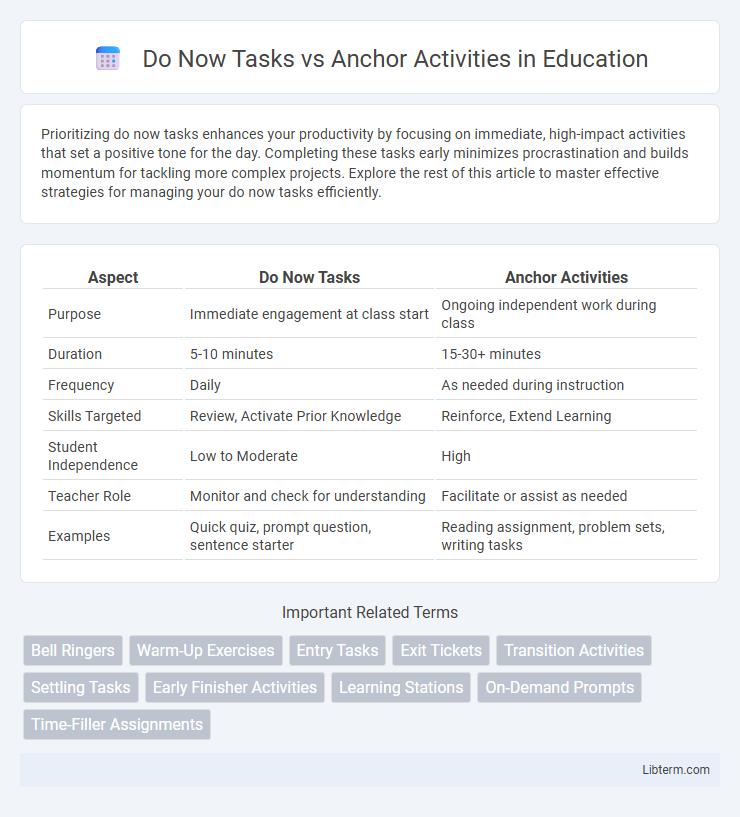Prioritizing do now tasks enhances your productivity by focusing on immediate, high-impact activities that set a positive tone for the day. Completing these tasks early minimizes procrastination and builds momentum for tackling more complex projects. Explore the rest of this article to master effective strategies for managing your do now tasks efficiently.
Table of Comparison
| Aspect | Do Now Tasks | Anchor Activities |
|---|---|---|
| Purpose | Immediate engagement at class start | Ongoing independent work during class |
| Duration | 5-10 minutes | 15-30+ minutes |
| Frequency | Daily | As needed during instruction |
| Skills Targeted | Review, Activate Prior Knowledge | Reinforce, Extend Learning |
| Student Independence | Low to Moderate | High |
| Teacher Role | Monitor and check for understanding | Facilitate or assist as needed |
| Examples | Quick quiz, prompt question, sentence starter | Reading assignment, problem sets, writing tasks |
Introduction to Do Now Tasks and Anchor Activities
Do Now Tasks are brief, focused activities designed to engage students immediately at the start of a lesson, promoting quick review or preparation for new content. Anchor Activities consist of meaningful, independent tasks that students work on consistently throughout the class, allowing for deeper exploration and extended engagement with the material. Both strategies enhance classroom management and student productivity by providing structured opportunities for active learning and smooth transitions between lesson segments.
Purpose and Objectives of Do Now Tasks
Do Now Tasks serve as quick, focused activities designed to engage students immediately at the start of a lesson, reinforcing prior knowledge or prepping them for new content. Their primary objective is to maximize instructional time by minimizing downtime and activating students' cognitive processes right away. These tasks promote classroom management efficiency and set a purposeful tone, ensuring students transition smoothly into deeper learning activities.
Purpose and Goals of Anchor Activities
Anchor activities serve as ongoing, meaningful tasks designed to engage students independently while the teacher supports small groups or individuals, promoting self-directed learning and reinforcing key concepts. These activities aim to deepen understanding, foster critical thinking, and maintain classroom productivity beyond immediate instruction. Purpose-driven anchor tasks support differentiated learning by allowing students to apply skills at their own pace, facilitating continuous academic growth.
Key Differences Between Do Now Tasks and Anchor Activities
Do Now Tasks are short, focused activities designed to engage students immediately at the beginning of a lesson, promoting quick review or activating prior knowledge. Anchor Activities, in contrast, are longer, self-directed tasks that students can work on independently when they finish assigned work early, supporting differentiated learning and time management. The key difference lies in their timing and purpose: Do Now Tasks kick-start class engagement, while Anchor Activities provide ongoing, meaningful work throughout the lesson.
Benefits of Incorporating Do Now Tasks
Incorporating Do Now tasks enhances classroom efficiency by immediately engaging students at the start of the lesson, promoting a focused learning environment. These brief, purposeful activities reinforce prior knowledge and activate critical thinking, leading to improved retention and student participation. Do Now tasks also streamline classroom management, minimizing downtime and maximizing instructional time.
Advantages of Using Anchor Activities
Anchor activities provide continuous learning opportunities by engaging students independently while the teacher addresses individual needs. These tasks promote student autonomy, enhance time management, and sustain classroom focus through meaningful, skill-reinforcing assignments. Integrating anchor activities supports differentiated instruction and helps maintain classroom order during transitions or regrouping periods.
When to Use Do Now Tasks in the Classroom
Do Now Tasks are most effective at the beginning of a lesson to engage students immediately and activate prior knowledge. These quick activities help streamline classroom transitions and establish a focused learning environment by minimizing downtime. Implement Do Now Tasks consistently to boost student readiness and set clear expectations for the day's objectives.
Effective Times for Employing Anchor Activities
Anchor activities are most effective during transitional periods in the classroom, such as the beginning of lessons, after recess, or while the teacher works with small groups, ensuring continuous student engagement. These tasks promote independent learning and reinforce concepts without requiring direct supervision, making them ideal for maximizing productive classroom time. Employing anchor activities during these intervals fosters classroom management and supports differentiated instruction by allowing students to work at their own pace.
Practical Examples of Do Now Tasks vs Anchor Activities
Do Now tasks, such as a quick quiz on yesterday's lesson or a 5-minute journal entry summarizing key points, are designed to engage students immediately at the beginning of class and activate prior knowledge. Anchor activities include independent assignments like reading comprehension exercises or math problem sets that students work on after completing the main lesson, allowing uninterrupted instruction for the teacher. Practical examples demonstrate that Do Now tasks facilitate smooth classroom transitions, while anchor activities provide meaningful, self-paced learning opportunities.
Choosing the Right Strategy for Your Classroom
Do Now tasks provide quick, focused starters that engage students immediately upon entering the classroom, promoting routine and maximizing instructional time. Anchor activities offer independent, meaningful work students can complete at their own pace, supporting differentiated learning and classroom management. Selecting the right strategy depends on the lesson's objectives, student readiness, and the need for structured transition or self-paced engagement.
Do Now Tasks Infographic

 libterm.com
libterm.com